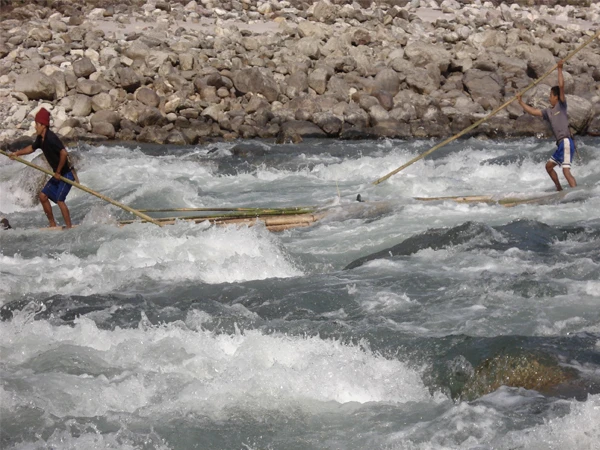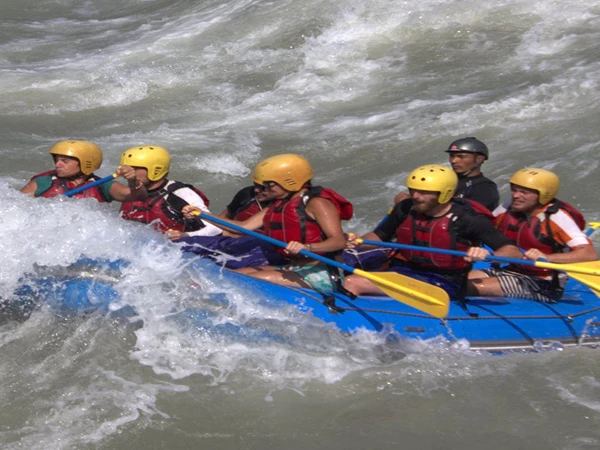Trishuli River
The Trishuli River is one of Nepal's most famous and accessible rivers. The river originates from the beautiful Himalaya. The river is formed by the merger between Kyirong Tsangpo and the Lende Khola which originates in the Gyirong County of Tibet. It gets its stream from the melting ice caps of the Langtang Himal and Gosaikunda. The river travels south, cutting through the hills and valleys which stand in its path. Eventually it joins the Narayani River. The river Trishuli is named after the divine trident (Trishul) of Lord Shiva, who is also known as the destroyer of the world. This causes the river to not only have economic and cultural significance but a religious significance as well.
The Trishuli river begins its journey from the Gosaikunda Lake, a spiritual place for both buddhists and hindus. The lake is located at an altitude of roughly 4,300 meters in the Rasuwa district. The continuous melting throughout the year has helped Trishuli to have a consistent flow throughout the year. The river makes a quick descent creating deep gorges as it swiftly travels through the Mahabharat range. Eventually it merges with the Narayani River in the Terai and passes through the well known Hindu pilgrimage site known as Devghat.
The river flows through several districts such as Rasuwa, Nuwakot, Dhading, Chitwan and Gorkha. It also plays a vital role in Nepal's growing hydroelectricity development as a number of hydroelectric projects are constructed within the river's reach. Projects such as the Trishuli Hydropower Plant, Upper trishuli and Supper Trishuli projects are some of the examples of such projects.
Other than the cultural significance, the Trishuli also contribute a lot to Nepal's economy. This is done mainly via tourism and energy production through Hydro. One of the most famous activities in the Trishuli is for white water rafting. Trishuli has rapids from Grade 2 to Grade 4 making it a hub for families and adventure seekers alike. The river has a variety of grades making it the ideal destination for both beginners and seasoned rafters. The white water rafting spot is approximately 2 to 3 hours away from the capital city Kathmandu, which makes it a great spot to visit and do adventure sports. The river can be reached via booking a private vehicle or hopping on local buses which drop you along the way.
Rafting Companies have created many beautiful camps and resorts along the riverbanks of Trishuli. Most notably River Fun Beach Resort is one of the go places if you are planning for the rafting trip. Similarly rafting companies such as Himalayan River Fun provide safety and experienced guides to help make the rafting more enjoyable and safe. These resorts offer many adventure packages that include rafting, kayaking, canyoning and resort stay. The white river rafting and growth in hydro has caused an exponential growth in local business. Another key factor to the growth is due to the fact that the river lies in the epicenter between 3 major cities, Pokhara, Kathmandu and Chitwan. Companies such as Real adventure Nepal help create an enjoyable and efficient package for you to enjoy your best trip whilst in Nepal.
Despite the beauty and economic benefits of the river. Trishuli also faces environmental challenges. Unregulated sand mining, deforestation and pollution from the camps and hotels near the river banks has caused an ecological imbalance in the river. On top of this development of hydro and nearby roads has increased the risk of landslides and changed the natural water flow of the river. This has caused to be a problem for both the environment and the human settlement in the region,
Although this may be the case, efforts have been made by local communities and the government to practice sustainable development and conservation of the river. These goals include eco-tourism initiatives, community based conservation programs and stricter laws by the local and federal government.
The Trishuli Khola is more than just a river. It is a symbol of Nepal's culture, economy and environment. With proper management and sustainable practices, the river can continue to
provide for future generations as a vital resource and a picture of Nepal's natural beauty.






